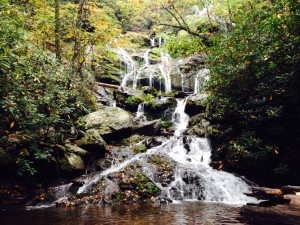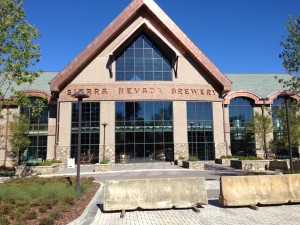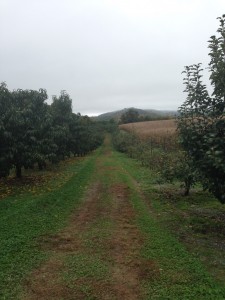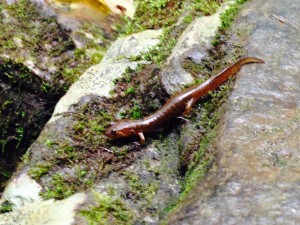Today I give you Part 2 of my two-weekend Asheville extravaganza.
Asheville, it turns out, is a treasure trove for those interested in water and geologic sciences. All you have to do is look at the Great Smoky and Blue Ridge Mountains, take a trip down the Blue Ridge Parkway, and ramble along some trails to find great rock structures and waterfalls galore.

The area surrounding Asheville has many popular hiking destinations due to the abundance of waterfalls and beautiful deciduous forests. I emphasize “deciduous” because the falling leaves were the main event of my fall break weekend.
But first, let me tell you about beer.

On the second day of the class trip to Asheville, our group headed out to Mills River, NC, where we visited the brand new Sierra Nevada Brewery. Our goal was to learn about the sustainability of the beer-making and bottling procedures handled at this new location, with an emphasis (of course) on water sustainability and treatment. The original location of Sierra Nevada Brewery is in Chico, CA, where I’m sure there are worse water availability issues than here in the lush mountains of North Carolina.
At this new location, the main point our tour guide focused on was waste water treatment. They have huge water treatment buildings onsite, which was pretty cool, and you could smell the aroma of anaerobic digestion processes wafting on the breeze. Bliss.
According to the Brewery’s sustainability report, they limit their burden on municipal water supplies by treating their own waste water and releasing it back to the municipal system. This is good news for all of the other breweries in Asheville. Since water is a primary ingredient in beer, it is important to breweries that there be an adequate local source of water. Below are the steps, as I understand them, that Sierra Nevada Brewery takes to treat waste water prior to releasing it back to the municipal system.
1) Send water through a mechanical filter (e.g., a screen) that sifts out any remaining grains in the water.
2) Equalize water for correct temperature and pH.
3) Send water to an anaerobic digester. Sierra Nevada uses the gases produced in this phase to fuel their boilers.
4) Treat water in an aeration basin, which removes remaining biological compounds.
5) Finally, treat water in a clarifying basin, which allows any remaining solids to settle out.
Conducting waste water treatment onsite, using gases from anaerobic digestion as fuel, and returning clean water to the municipal water supply are all measures that both increase the sustainability of Sierra Nevada’s operations and decrease the Brewery’s water and sewerage bills.
In many parts of the country (not to mention the world), water availability will become an increasingly pressing issue in the coming years. Businesses that take the initiative now to switch to more sustainable procedures may more easily operate as water scarcity increases. These businesses may also be better prepared financially to deal with rising costs of water and energy resources.
I was glad to get the opportunity to learn about sustainable water practices in the brewery world. The intersection of water and the food/beverage industry defines an intriguing set of challenges that will only continue to grow. Businesses involved in the food and beverage industry face important decisions in the future in securing and efficiently using water resources. In terms of the U.S., this is especially true of businesses in more water-limited areas (I’m looking at you, California).
With thoughts of the food and beverage industry in mind, I went back to school to study up on water resources before returning to Asheville for fall break. I made sure to sample some of Asheville’s food and beverage offerings at their Oktoberfest and at restaurants around town. The best part of my second trip to Asheville, however, were the great outdoors.

My roommate and I took a lovely trip to a pick-your-own apple farm. We ambled through rows of apple trees, hunted the best apples for flavor and beauty, and sampled some of the farm’s apple pastries. We also took some time to lounge in a pumpkin patch. (Yes, I do use the word “lounge” intentionally. It was very relaxing.)
The rows of apple trees were framed in the background by the Great Smoky Mountains. Most of the views of mountains were shrouded in clouds, unfortunately, because the weather around Asheville that weekend was mostly rainy and cloudy.

The other main event of the trip was hiking. We took a couple of hikes, one in an experimental forest where I found some clay combined with water flow:

Our other hike was to Catawba Falls, suggested by fellow blogger, Ian. The hike up was an easy hour or less– it’s hard to know exactly how long the hike was, considering I spent ample time hopping around on rocks in creeks and sticking my hands in stream sediments. My roommate spotted a great salamander friend:

After hiking at Catawba Falls, we drove back up to Durham and said goodbye to our wanderings in nature. I ended my two weekends in Asheville with some interesting ideas about water sustainability in business practices, as well as some great memories of outdoor adventures and the beautiful Fall colors.
I also had a whole lot of apples to eat.
“Those who contemplate the beauty of the earth find reserves of strength that will endure as long as life lasts.”
– Rachel Carson, The Sense of Wonder

